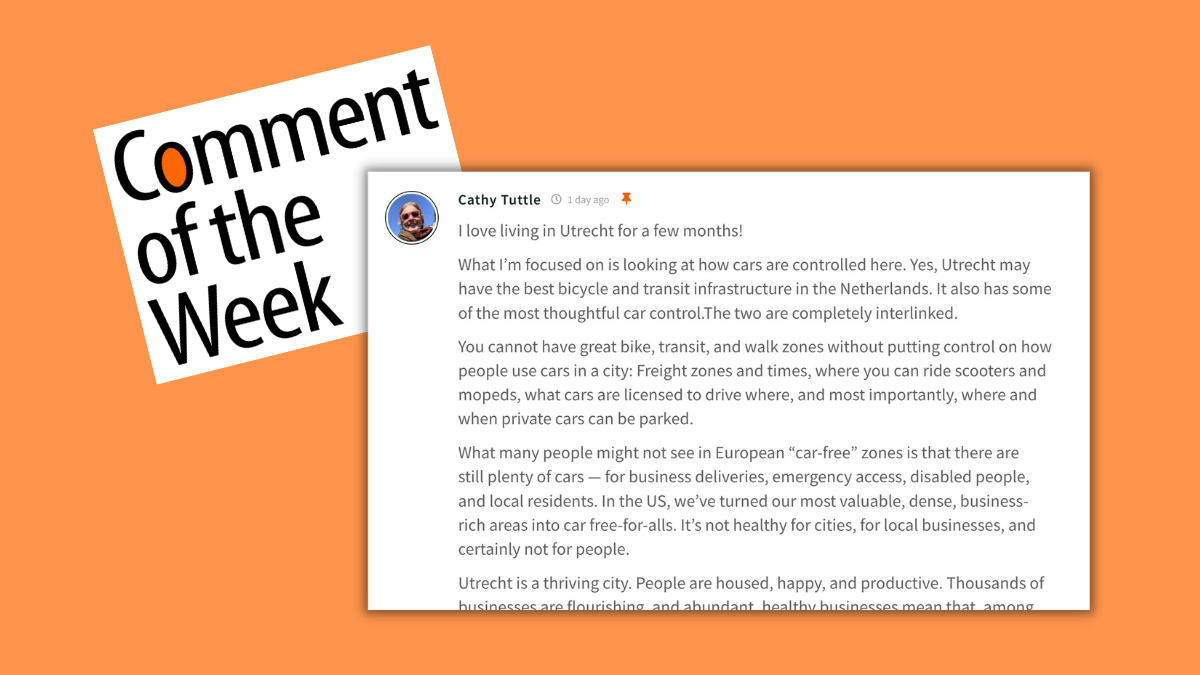Welcome to the Comment of the Week, where we highlight good comments in order to inspire more of them. You can help us choose our next one by replying with “comment of the week” to any comment you think deserves recognition. Please note: These selections are not endorsements.
Sometimes getting a clear view of Portland requires stepping back 6,000 miles. That’s what Cathy Tuttle did when she commented from Utrecht about Taylor Griggs’s post, A ‘Living Streets’ plan for downtown Portland.
Tuttle was an advisor to the four Portland State University students who created the “Living Streets” plan, and she picked up where Taylor left off with some insight about how controlling — not abolishing — cars is key to successful European “car-free” zones.
Here’s what Cathy wrote:
I love living in Utrecht for a few months!
What I’m focused on is looking at how cars are controlled here. Yes, Utrecht may have the best bicycle and transit infrastructure in the Netherlands. It also has some of the most thoughtful car control. The two are completely interlinked.
You cannot have great bike, transit, and walk zones without putting control on how people use cars in a city: Freight zones and times, where you can ride scooters and mopeds, what cars are licensed to drive where, and most importantly, where and when private cars can be parked.
What many people might not see in European “car-free” zones is that there are still plenty of cars — for business deliveries, emergency access, disabled people, and local residents. In the US, we’ve turned our most valuable, dense, business-rich areas into car free-for-alls. It’s not healthy for cities, for local businesses, and certainly not for people.
Utrecht is a thriving city. People are housed, happy, and productive. Thousands of businesses are flourishing, and abundant, healthy businesses mean that, among other things, roads and public spaces are in good repair and transit is clean, safe, and frequent.
This is all preamble to say that the TREC/PSU report on Living Streets is on the right path, and is a very good blueprint for local Portland business and political leaders to use, as soon as they have the courage to do so.
The four student authors, Cameron Bennett, Owen Christofferson, Emily D’Antonio, and Aidan Simpson have provided solid, data-based guidance. I hope they all end up in positions in Portland or other cities where these transformations are needed soon.
Reading their 79-page report may be daunting for some. I want to point out just a few pages to focus on. The authors did a deep dive into what “Living Streets” are in a dense downtown context. Here’s their plan.
Living Streets are the “Living Rooms” of cities. More detailed descriptions of what a Living Street is (these descriptions could be used by City planners working respectfully on public outreach) are on page 44. The student report has valuable lists of possible design elements (p. 29) and cost estimates (p.67). These are all good public engagement tools.
Because Portland leaders are not ready to draw a ring around the whole downtown as a living streets area (they should!), this report highlights Opportunity Areas (p.21) that are basically smaller places that can be adapted to a car-lite approach because they have zero or few driveways. The Opportunity Areas also lead to dense residential and business destinations that people want to go to.
I am convinced, if areas downtown adopt a Living Streets approach, they will draw in more people, who will support more businesses, who will help more of Portland’s downtown thrive. Uncontrolled car driving and more cheap car parking does not make Downtown Portland more inviting.
The Downtown Portland Living Streets Plan narrows its focus to just four destination areas and goes into detail about how they could be designed and what it would cost to do demonstrations and permanent designs for each of them. These four areas: Old Town, Burnside Wedge, Extended Halprin, Transit Mall, were chosen with a robust data-focused process that’s worth a look (See page 64: Weighted Decision Matrix Criteria).
I believe any of these demonstration areas — all of them and more in fact! — will improve the quality of life for people who live in Portland, increase the city business tax base, and draw new visitors to a city where the dream is once again alive.
Thank you Cathy! You can find Cathy’s comment under the original post.
And I want to say a few words about the other comments in this thread. Once you get to the far side of the apocalyptic stuff at the beginning, this is a fascinating thread. Watch the video John links to; appreciate BlumDrew’s and J1mb0’s discussion of density and the Portland region; don’t miss qqq on the role of parks.
The thread sent me into a couple hours of thinking over my 20-plus-years relationship with downtown Portland. Don’t worry, I won’t bore you with it, except to say that the present state of the city was a long time in the making. I’ve turned identifying the first sign that things were amiss into a personal parlor game.

Lisa Caballero has lived in SW Portland for over 20 years. She is on the Transportation Committee of her neighborhood association, the Southwest Hills Residential League (SWHRL) and can be reached at This email address is being protected from spambots. You need JavaScript enabled to view it..


